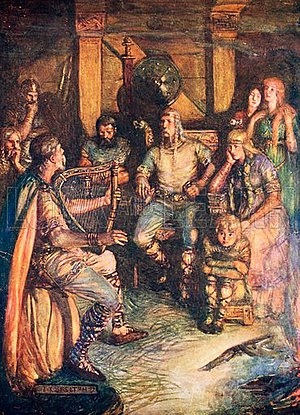
The difficulty of translating Beowulf from its compact, metrical, alliterative form in a single surviving but damaged Old English manuscript into any modern language is considerable,[1] matched by the large number of attempts to make the poem approachable,[2] and the scholarly attention given to the problem.[3]
Among the challenges to the translator of Beowulf are whether to attempt a verse or prose rendering;[3] how closely to stick to the original;[4] whether to make the language archaic or to use distinctly modern phraseology;[4] whether to domesticate or foreignize the text;[4] to what extent to imitate the original's laconic style and understatement;[5] and its use of intentionally poetic language to represent the heroic from what was already an ancient time when the poem was composed.[5]
The task of the poet-translator in particular, like that of the Anglo-Saxon poet, is then to assemble multiple techniques to give the desired effects.[6] Scholars and translators have noted that it is impossible to use all the same effects in the same places as the Beowulf poet did, but it is feasible, though difficult, to give something of the feeling of the original, and for the translation to work as poetry.[7]
- ^ Alexander 2003, pp. liii–lvi.
- ^ Cite error: The named reference
Mize 2020was invoked but never defined (see the help page). - ^ a b Magennis 2011, pp. 13–15.
- ^ a b c Magennis 2011, pp. 7–13.
- ^ a b Alexander 2003, pp. xlviii–li.
- ^ Liuzza 2013, p. 36.
- ^ Alexander 2003, p. lv.